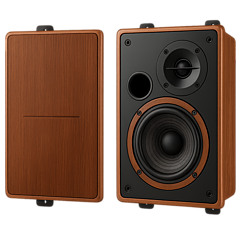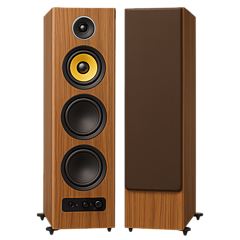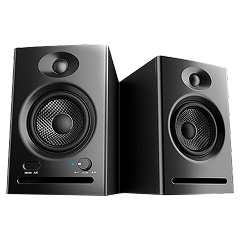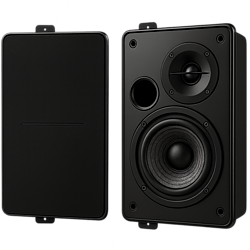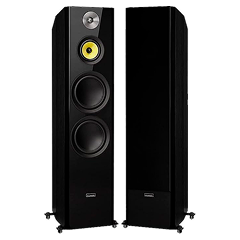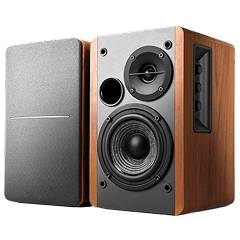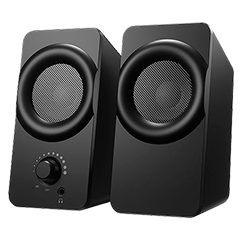Floorstanding speakers offer scale, bass extension, and a commanding presence that smaller bookshelf or standmount speakers cannot match. When these speakers are powered or active, they combine the benefits of integrated amplification with the sonic impact of a large cabinet, providing convenience and high-quality audio in one package. This guide focuses on the unique considerations of powered/active floorstanding systems.
The Mains Attraction
For powered loudspeakers, the chances are that only one of the speakers will need to be connected to the power supply. For active speakers, it’s almost certain that both speakers will need to be plugged into the mains.
So, as well as taking account of all the issues that can arise when positioning a pair of floorstanding speakers—particularly the size of room they need to perform at their best, and the influence boundaries can have on bass reflex ports in particular—the specifics of power must be borne in mind too. Nothing is more certain to spoil your carefully considered interior decor choices than long and unsightly lengths of mains cable running from a loudspeaker (or two) to inconveniently positioned sockets in the wall.
- Ensure at least one mains socket per speaker (or one per system for powered models).
- Consider cable management solutions to avoid clutter and maintain aesthetics.
Connecting Speakers and Sources
The visual impact of your speakers could be compounded by the fact that not only may they need to be connected to each other, but they could also require connections to physical sources of music.
A pair of powered speakers generally requires wiring together because only one speaker carries amplification. Many pairs of active speakers also need joining together to operate at maximum resolution.
If you’re using strictly wireless sources (streaming from a smartphone or laptop), that may be the end of the wiring required. But if you plan to use legacy sources like a turntable or CD player, they must be connected to the speaker that hosts all the physical inputs. Keep in mind that these sources will have mains power requirements of their own.
Hearing is Believing
The most crucial step is auditioning the powered/active floorstanding loudspeakers you are considering.
Because these are floorstanding speakers, you are entitled to expect a gratifying scale of sound, a large soundstage, and significant low-frequency extension and impact. Refer to technical specifications for frequency response, sensitivity, and total harmonic distortion if available, but the ultimate test is listening.
Then—and this is the single most important point—choose the pair that sounds best to you. No one else’s opinion—neither ours nor the salesperson’s—matters as much as yours.
Cabinet Design and Build Quality
When it comes to floorstanding speakers, the cabinet isn’t just a box—it’s a critical part of the sound. A well-built cabinet reduces unwanted vibration and resonance that could interfere with the drivers. Look for materials such as MDF, HDF, or high-quality composites, and check whether the internal structure includes bracing or damping to keep the cabinet rigid. A solid, heavy-feeling cabinet is usually a good sign that the speaker has been designed to remain stable and quiet, letting the drivers do their work without interference.
Driver Configuration and Size
The size and number of drivers in a floorstanding speaker directly influence the scale of the sound it can produce. Larger woofers move more air, giving you deeper bass, while additional midrange and high-frequency drivers improve clarity and separation. Many two-way designs will include a woofer and a tweeter, while three-way designs add a dedicated midrange driver for more accurate reproduction. For a typical living room, look for at least one 6–8” woofer, though larger drivers may be necessary if your space is generous or you want that full concert-hall experience.
Integrated Amplification Specs
One of the key advantages of powered or active speakers is that the amplifier is designed to perfectly match the drivers. Still, it’s important to consider output power and how it’s distributed. Some active designs give each driver its own amplifier, which improves control and headroom, while powered designs may have one amplifier handling multiple drivers. As a guideline, look for RMS power ratings of at least 50–100 W per channel for medium-sized rooms; more power may be necessary for large spaces to maintain dynamic range and clarity at higher volumes.
DSP and Room Tuning Features
Some modern powered floorstanding speakers include digital signal processing to help the speaker adapt to the room it’s in. DSP can compensate for things like bass buildup in corners or absorption by carpets and curtains, giving a more balanced and controlled sound. If your chosen model includes this, check whether you can adjust the low, mid, and high frequencies independently. Even a few dB of adjustment across these ranges can make a significant difference in how the speaker sounds in your space.
Placement Flexibility
Even the largest, most capable floorstanding speakers can be held back by poor placement. Ideally, you want to give them space on all sides so they can breathe and project a clear soundstage. Keep at least 30–50 cm from side walls and 50–100 cm from the back wall, especially if the speakers have rear-firing bass reflex ports. This will help prevent boomy bass and preserve midrange clarity, letting the speakers sound their best.
Maintenance and Warranty
Think about the long term. Removable grilles make it easier to clean the drivers and ensure they remain unobstructed, while replaceable driver units can extend the life of your speakers. Pay attention to the warranty, too: a term of 2–5 years for both the cabinet and amplification components gives peace of mind and indicates the manufacturer’s confidence in their product.


